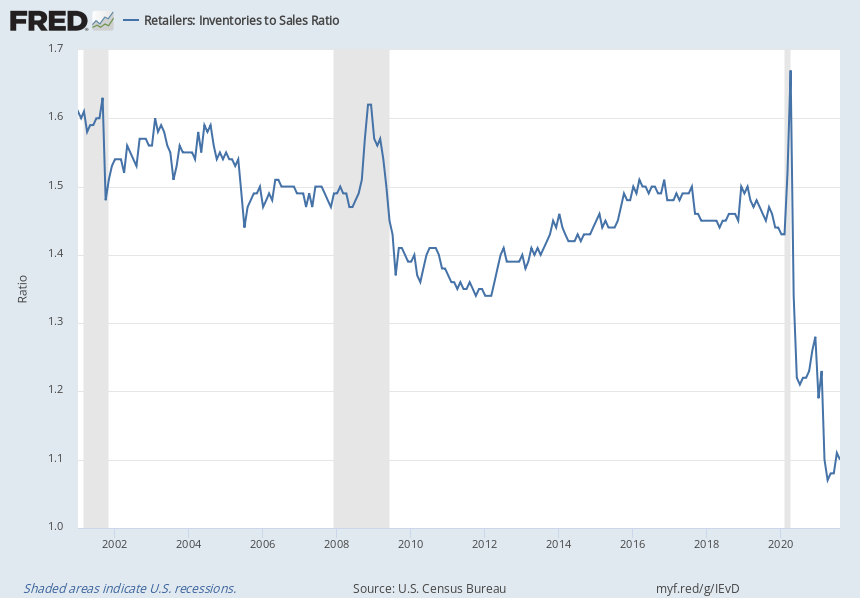The Global Shipping Crisis
The Global Logistics Shipping Crisis: All-time High Import Volume, But We’re Not Catching Up
The U.S. continues to be one of the more overachieving economies in the world as import volumes continue to run at a record pace. Despite this success, retail inventory levels are not catching up as a percentage of sales. As long as demand for goods grows in 2022, there will not be a break from the frenetic pace we are currently seeing today. The December update of the logistics and economic metrics Descartes is tracking point to longer lasting effects to global supply chains.
In this Article...
- toc
November was an even stronger month for U.S. Import Volume
With a shorter month and the Thanksgiving Holiday, November traditionally has a lower import volume than October. However, compared to November 2020 and 2019, the volume was up 12% and 34%, respectively. For further context, only 1 other month in the prior 2 years (October 2020) had a higher container import volume. Many retailers accelerated their peak season imports in 2021 to address the shipping capacity crunch, but that hasn’t translated to a decline at year-end. We continue to expect December 2021 TEU volume to be between 2.4M and 2.6M which will continue to stress ports and inland logistics.
Figure #1: U.S. Container Import Volume Year-over-Year Comparison

Source: Descartes Datamyne
The combination of ships waiting and increasing port delay times indicate that December looks to be another strong container import month.
Instead of decreasing, the number of ships at or waiting to berth is at an all-time high. To put it in context, 31 were at berth and 96 ships are waiting off West Coast ports and across the Pacific as of December 1st1. That’s up 25% since the beginning of November and 79% higher than the beginning of September.
Port delays are not improving – quite the opposite. Using Descartes Datamyne™ to track delay times at the Port of Los Angeles since August (15.3 days delay) reveals that while there was a slight decrease of 0.9 days through October, November delays actually increased 0.2 days to 14.4 days. Expanded tracking of the Port of New York/New Jersey and The Port of Savannah also shows increases in November by 2.4 days to 10.8 days and 1 day to 10.7 days respectively. The Port of Long Beach was 15.0 days in November and even smaller ports such as Oakland (11.9 days), Seattle/Tacoma (11.9 days) and Norfolk (8.0 days) have relatively long delay times.
Another interesting observation is that import container volume processing growth is occurring away from the 2 largest ports, Los Angeles and Long Beach. The number of TEUs processed in equal length months of May and October shows that the Port of Los Angeles (-3.0%) and the Port of Long Beach (-3.5%) declined. However, overall, the U.S. imported 0.3% more TEUs in October versus May. This Descartes Datamyne analysis points to importers and LSPs shifting to alternate ports to avoid the West Coast bottleneck situation.
Inventory levels continue to run far below traditional ratios and events in 2022 could make it hard to improve them.
The inventory to sales ratio (see Figure 2) tracked by the U.S. Federal Reserve slightly declined again (1.1 in August and 1.09 in September, the latest update). This indicates that retailers have not been able to get beyond the peak season inventory demands in the second half of 2022. In addition, a number of events in 2022 conspire to make it hard for importers to elevate them in early to mid-2022. February could be a deceptively slow import month as the Chinese New Year (Feb. 1st) traditionally depresses imports. However, the Olympics (Feb. 4th – 20th) could further depress that month’s shipping volumes as the desire to reduce pollution, especially during the Olympics, could cause many parts of the Chinese economy to curtail operations2 before and during that time.
Figure 2: FRED Retailers: Inventory to Sales Ratio

West Coast port processing capacity could be severely impacted in the spring of 2022. An offer from the Pacific Maritime Association to extend the ILWU contract to July 1, 2023 was rejected3. The ILWU contract ends July 1, 2022, and the ILWU have decided to enter into negotiations. With a history of contentious relations, retailers and manufacturers will accelerate shipments earlier in 2022 to mitigate the impact of any stoppages. This acceleration will impact capacity for any company trying to use the traditionally “soft” winter import volumes as a place to replenish stock.
Consumers are not giving global supply chains a break.
The engine driving all of the import volume increases, low inventory and rising number of ships waiting to enter West Coast is consumer consumption of personal goods. With a strong economy and limited opportunities to spend their money on services (e.g. travel, restaurants and events), consumers are buying more durable and non-durable goods. In fact, the ratio of goods to services increased 1% to 54% as of October 1st, according to the latest data available (see Figure 3). The Delta and now Omicron variants of the COVID-19 virus are continuing to depress consumer services expenditures and without another avenue for consumers to spend their money, the demand for goods and related logistics services will not decline anytime soon.
Figure #3: Personal Consumption Metrics

To access other articles that track port congestion monthly, visit the
Global Shipping Resource Center
White Papers
Survey Uncovers Supply Chain Strategies of Top Performing Companies
Surviving Peak Season and Beyond: The Essential Guide to Supply Chain Resiliency

Executive Vice President of Industry and Services
Descartes Systems Group
Global Trade Intelligence Key to Minimize Supply Chain Delays

Descartes recently conducted a benchmark survey and uncovered the supply chain resiliency strategies of top-performing companies.
Get your copy of the survey results and find out key steps you can take to reduce risk and create a more resilient supply chain.
Get Your Copy
Sorry to sound like a broken record. Unless consumer behavior changes or the economy stalls, demand for goods and the associated logistic services to get them to market will continue at elevated levels through 2022. Descartes will continue to highlight key U.S. government and industry data in coming months to provide insight into the global shipping crisis. Our perspectives and recommendations are:
Don’t treat this like a short-term problem or everyday you’ll find yourself waking up to Sonny and Cher.
There is nothing in the logistics and economic data that indicates the global logistics crisis is a short-term problem that can be waited out. Risk mitigation tactics continue to need to be employed, but supply chain strategies need to be adjusted as well. Descartes will highlight key Descartes Datamyne™, U.S. government and industry data that provides insight into the global shipping crisis. Our recommendations remain the same with an additional one on resources:
Short-term:
- Shipping capacity constrained? Rationalize SKUs to ship higher velocity and margin goods to maximize profitability.
- Focus on keeping the supply chain resources you have, especially drivers. The old adage “a bird in the hand is worth more than 2 in the bush” definitely applies here. Building trips to reduce stress and improve quality of life to retain drivers is now as or more important than wage increases.
Near-term:
- Shift the movement of goods to less congested transportation lanes to improve supply chain velocity and reliability. Total transit time is important, but so is supply chain predictability. Evaluate alternative transportation lanes into the U.S. including entry through northern and southern borders and inland ports.
Long-term:
- Evaluate supplier and factory location density to mitigate reliance on over-taxed trade lanes. Density creates economy of scale, but also risk, and the pandemic and subsequent logistics capacity crisis highlight the downside.
1 Maritime Exchange of Southern California and American Shipper
2CNBC
3 Bloomberg
How Descartes Can Help
Descartes Datamyne delivers business intelligence with comprehensive, accurate, up-to-date, import and export information.
Our multinational trade data assets can be used to trace global supply chains and our bill-of-lading trade data – with cross-references to company profiles and customs information – can help businesses identify and qualify new sources. Ask us for a free, no obligation demonstration of our data on a product or trade commodity of your choosing – and keep the custom research we create with our compliments.
